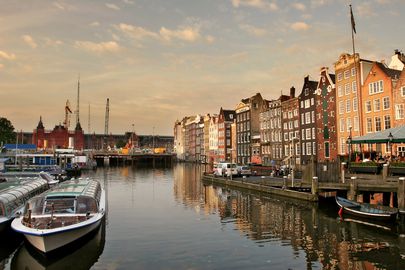

The name Amstel originates from the word aeme-stelle, which in Old Dutch means a 'water-like area'. The river originally started at the confluence of the smaller Drecht and Kromme Mijdrecht rivers just southwest of Uithoorn. However, after the construction of the Amstel-Drecht canal, the source moved to where Drecht meets Aarkanaal just outside the town of Nieuwveen.
In the Middle Ages, the local population mined the Amstel for peat which was used for agriculture and, later on, as fuel. The oldest settlement on the Amstel is probably Ouderkerk aan de Amstel, located about 10 kilometers up the river from Amsterdam and dating two centuries earlier than the Dutch capital.
Along the northern stretch of the Amstel, not far from where it used to empty into the IJ (the body of water behind the Central Station), on both sides of the current Rokin and Damrak, was established a fishing village called Amstelredam. It came into existence when a dam was constructed in the 13th century at the mouth of the river. The original dam was exactly where Dam square is located nowadays. The oldest record of Amsterdam dates to October 27, 1275 and it acquired city rights shortly after year 1300.
The fishing hamlet quickly grew into the town of Amsterdam, which had strategic importance because of its location on the Zuiderzee, with connection by sea to northern Germany and Scandinavia and, through a network of rivers, to the bustling trade cities of Dordrecht and Antwerp in the south.
Originally, the river emptied via the current Rokin and Damrak into the IJ. In 1936, however, the Rokin was filled in and the Amstel river now ends between the Munt and the Dam square. The last stretch along the former Amstel River past the Munt is called the Inner Amstel. Some of the river current still flows through pipes under the Damrak into the IJ, although most of it is redirected through the girdle of Amsterdam canals.
In the 17th and 18th centuries many country estates of wealthy Amsterdammers were built along the Amstel. As Amsterdam lost its economic muscle with the decline of the Golden Era, most of them have gradually disappeared. On the way to the Ouderkerk aan de Amstel, though, one may observe a few surviving old villas that have been restored and again have become home to the affluent and the rich.
During the record hot and dry summer of 2003, water shortage in the Dutch countryside resulted in large amounts of water being drained from the polders threatening to dry them out. For the first time in the river's history, through a complex network of drainages and pumps, it was decided to temporarily reverse the direction of the river so as to supply water to the affected areas. Thus, the river flowed southward for a few days, a costly operation which was paid for by the local governments of the threatened regions.